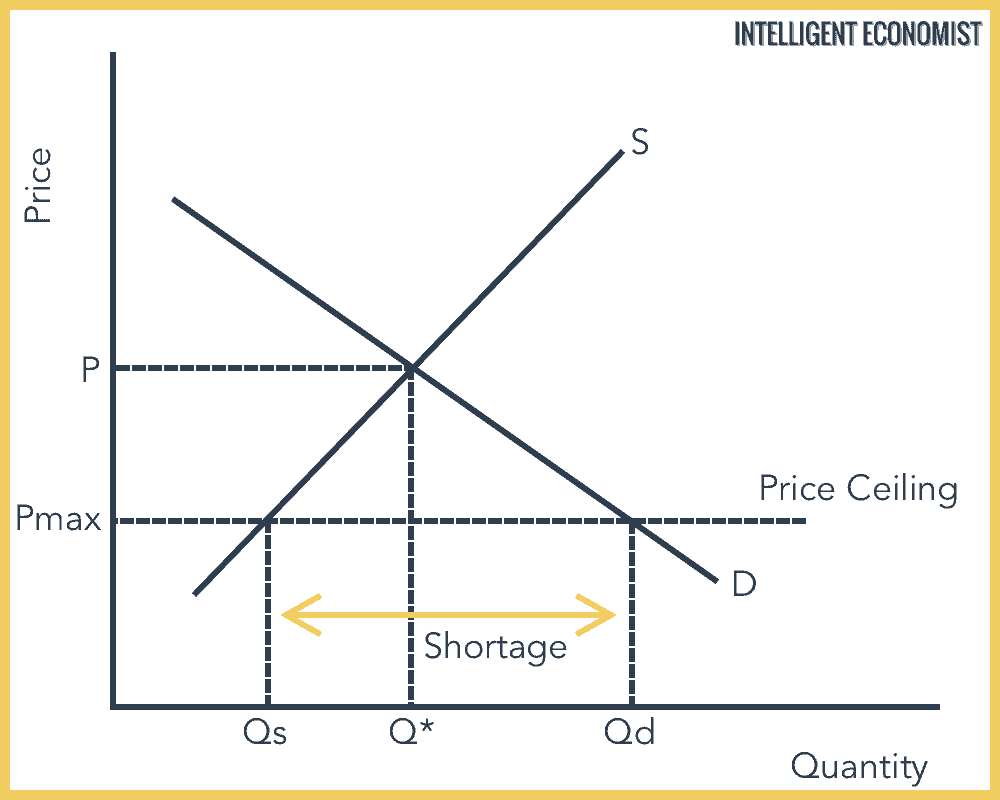A price control is instituted when the government feels the current equilibrium price is unfair and intervenes and adjusts the market price.
More specifically, a price ceiling (in other words, a maximum price) is put into effect when the government believes the price is too high and sets a maximum price that producers can charge; this price must lie below the equilibrium price in order for the price ceiling to have an effect.
The price ceiling is usually instituted via law and is typically applied to necessary goods like food, rent, and energy sources in order to ensure that everyone has access to them.
Benefits and Downsides
Price ceilings are beneficial to society, and are often necessary, in that they make sure that essential goods are financially accessible to the average person, at least in the short run. By lowering costs, price ceilings also have the beneficial effect of helping to stimulate demand, which can contribute to the health of an economy.
However, there can also be downsides to price ceilings. While they stimulate demand, price ceilings can also cause shortages. Where the ceiling is set, there is more demand than at the equilibrium price. This means that the amount of the good or service supplied is less than the quantity demanded.
For example: in agriculture, medicine, and education, many governments set maximum prices to make the needed goods or services more affordable. Producers may respond to such an economic situation by rationing supplies, decreasing production levels or lowering the quality of production, making the consumer pay extra for otherwise free elements of the good (features, options, etc.), and more.
Price Ceiling Graph
The price ceiling graph below shows a price ceiling in equilibrium where the government has forced the maximum price to be Pmax. Thus the actual equilibrium ends up below-market equilibrium.

The original price is P*, but with the price ceiling, the price falls to Pmax, and the quantity supplied is Qs, and the quantity demanded is Qd. The distance between Quantity Demand (Qd) and Quantity Supplied (Qs) is a shortage. There is a fall in producer surplus, but a significant jump in consumer surplus.
Binding vs. Non-Binding Price Ceilings
A binding price ceiling is a required price on a good that sits below equilibrium. The government demands that prices stay below that price, which “binds” the market with regard to that good. In effect, a binding price ceiling is a truly effective price ceiling.
By keeping the price artificially low, the government makes it so that firms are not motivated to produce sufficient amounts of the good as needed in the market. The result is often a shortage of whichever good has been subject to a binding price ceiling.
A non-binding price ceiling is ineffective due to the fact that the present equilibrium price is already below the price ceiling. For instance, if the government sets the ceiling for potatoes at $5 per pound, but the equilibrium price for potatoes is already $4 per pound, this would have no real effect on the price of potatoes. That’s because a price ceiling is a maximum, rather than an exact required price.
Real-World Price Ceiling Example
Rent Control
Rent control is a prominent price ceiling example. The local government can limit how much a landlord can charge a tenant or by how much the landlord can increase prices annually. Rent control aims to ensure the quality and affordability of housing in the rental market. New York and San Francisco have famous rent control laws.
Over the long run, however, rent control decreases the availability of apartments, since suppliers do not wish to spend the money to build more apartments when they cannot charge a profitable rent. Landlords not only do not develop any more apartments, but they also do not maintain the ones that they have, not just to save costs but also because they do not have to worry about the market demand.
Demand is already very high because there is excessive demand for rent-controlled apartments. According to many economists, this excess demand and limited supply for housing can ultimately lead to a massive housing shortage. Thus, according to survey data, a majority of economists would argue that “a ceiling on rents reduces the quantity and quality of housing available.”
Effects of a Price Ceiling
The distance Qd-Qs represents a shortage, as consumers will demand a higher quantity at the lower price Pmax than producers are willing to supply at that price. This leads to a distortion in the market.
Since there is a shortage, lines will form and/or black markets can emerge. The effect of a black market is that the government will face losses regarding revenues received from taxation. This is because goods traded on the black market are not registered, so no records will be available for tax collection.
The quality of products, in the long run, might worsen as producers are tempted to use cheaper factors or cut corners. Similarly, in the rental market, landlords may not want to maintain their apartments when the apartments are under rent control.
The government could increase supply by subsidizing the product or releasing previous stock (if any).


A rent ceiling prohibits charging rent that exceeds the ceiling amount. Suppose
government decides to put a rent ceiling.
(a) With the help of a diagram show the effect of a rent ceiling on the supply and demand
of a rented house if the ceiling is set below the market equilibrium rent.
(b) What will be the resultant effects on supply and demand of a rented house if the
ceiling is set above the market equilibrium rent?